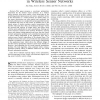186 search results - page 32 / 38 » Achievable Capacity Under the Interference Temperature Model |
TCOM
2008
13 years 7 months ago
2008
This paper proposes a cross-layer optimization framework for the wireless sensor networks. In a wireless sensor network, each sensor makes a local observation of the underlying phy...
MSWIM
2005
ACM
14 years 1 months ago
2005
ACM
We investigate the impact of power control on latency in wireless ad-hoc networks. If transmission power is increased, interference increases, thus reducing network capacity. A no...
INFOCOM
2010
IEEE
13 years 6 months ago
2010
IEEE
—In IEEE 802.22 Wireless Regional Area Networks (WRANs), each Base Station (BS) solves a complex resource allocation problem of simultaneously determining the channel to reuse, p...
MOBIHOC
2009
ACM
14 years 8 months ago
2009
ACM
Due to its low complexity, Greedy Maximal Scheduling (GMS), also known as Longest Queue First (LQF), has been studied extensively for wireless networks. However, GMS can result in...
CORR
2008
Springer
13 years 7 months ago
2008
Springer
Cooperation between rational users in wireless networks is studied using coalitional game theory. Using the rate achieved by a user as its utility, it is shown that the stable coal...

